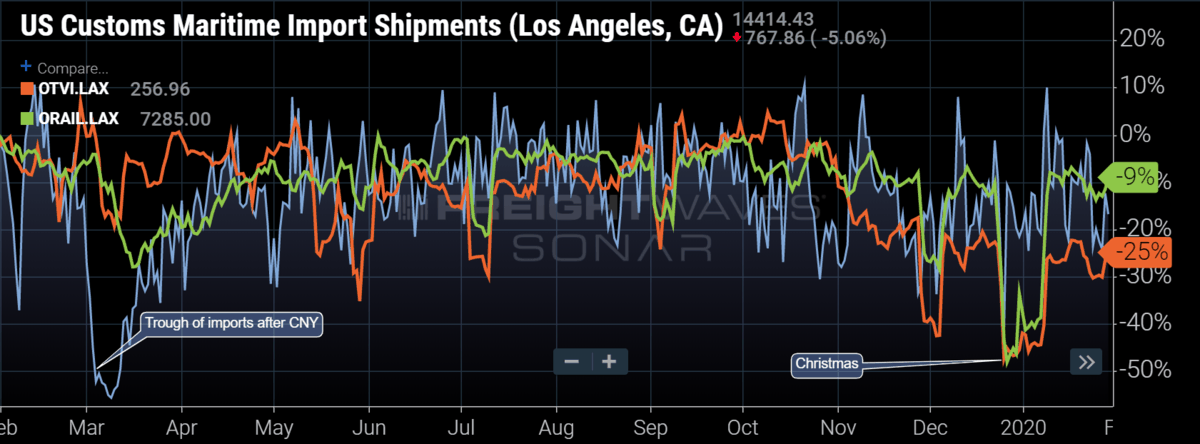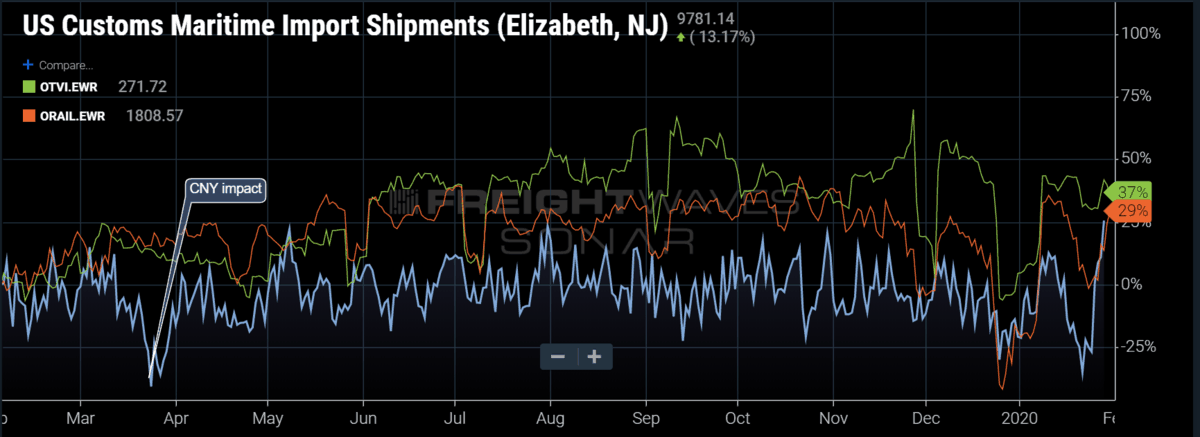
Chart of the Week: US Customs Maritime Import Shipments – Los Angeles, Outbound Tender Volume Index – Los Angeles, Outbound Rail Container Volumes – Los Angeles SONAR:CSTM.LAX, OTVI.LAX, ORAIL.LAX
The coronavirus outbreak which began in the Hubei province of China is creating disruption to the global supply chain. With over 12,000 confirmed infections and growing, the coronavirus, which is a group of viruses that can cross species from animals to humans, has caused countries to ban travel to and from China and shut down local factories and transportation in and out of the primary area of infection.
The Hubei province is roughly 500 miles (800km) from the world’s busiest container port of Shanghai and 650 miles from the Shenzhen province—a huge area for manufacturing and exports to the U.S. north of Hong Kong. Whereas both areas are a good distance from the region where the infections began, the outbreak became more serious as the largest national holiday of the year was beginning in China, Chinese New Year (CNY).
During Chinese New Year people leave the factories, take vacations and visit family. Many workers change jobs as this is a period of transition in the country. CNY is not just celebrated in China but in almost all Asian countries. The reason this is important for Americans is the fact our economy is very connected to Asia’s manufacturing and production cycles due to many companies pushing production to the Far East for lower cost of labor. Many of the goods we consume are produced overseas and are imported into the U.S.
According to FreightWaves lead economist, Anthony Smith, the U.S. economy is only about 12% manufacturing and 70% is consumption driven. Meaning the U.S. does not produce much of what it consumes. Most of the goods originate in China with other Asian countries contributing a healthy amount.
According to FreightWaves customs data, Chinese imports accounted for roughly 40% of the shipments entering the U.S. in the last month. All these goods are transported by rail or truck with most of these shipments entering the ports of L.A. and Long Beach in California. There is a sizable decrease in outbound shipments on both rail and truck about three to six weeks after CNY. Last year outbound L.A. rail volumes dropped 25% in early March and did not recover fully until April. L.A. outbound trucking volumes fell 20% but recovered more quickly by the end of the month.

East Coast imports are also impacted, but a few weeks later and with less immediate or discernible impact to rail or trucking volumes. Freight movements are not as directly tied to the ports on the East Coast due to all the other activity clouding the connection, at least in the short-term.
With 30-40% of the freight that moves in the country having entered through a port at some point — almost half of that freight comes from China — there could be a noticeable decline in freight volumes as a result of the loss of production from CNY and the coronavirus outbreak.
The virus is still not contained, which means we have not seen the peak of the impact just yet. A longer CNY trough is anticipated as the production remains offline and transportation is inhibited.
So far this year, truckload volumes have been on par with 2019 without much deviation, averaging 0.67% higher in January. Capacity has not been an issue, which has kept spot rates low and made it difficult for carriers to utilize their equipment, but even as much as a 1% decline in demand may further inhibit the beleaguered trucking sector and its potential recovery effort this year. Looking at tender rejection and spot market data late last year, there was some reason for optimism as the market appeared to have bottomed and was turning slightly upward. Developments like this may make the first half of 2020 more challenging.
About the Chart of the Week
The FreightWaves Chart of the Week is a chart selection from SONAR that provides an interesting data point to describe the state of the freight markets. A chart is chosen from thousands of potential charts on SONAR to help participants visualize the freight market in real-time. Each week a Market Expert will post a chart, along with commentary live on the front-page. After that, the Chart of the Week will be archived on FreightWaves.com for future reference.
SONAR aggregates data from hundreds of sources, presenting the data in charts and maps and providing commentary on what freight market experts want to know about the industry in real time.
The FreightWaves data science and product teams are releasing new data sets each week and enhancing the client experience.
To request a SONAR demo click here.











Fahad
There is no specific treatment for coronavirus. Treatment aims to relieve the symptoms.
Charles
This is definitely a government operation agent orange is in full effect maga rofl
Noble1 suggests SMART truck drivers should UNITE & collectively cut out the middlemen from picking truck driver pockets ! IMHO
UPDATE :
Quote :
Hong Kong announces new border closures, as China’s coronavirus death toll overtakes SARS
Scientists in China discovered over the weekend that fecal samples from patients infected with the Wuhan coronavirus tested positive for the pathogen.
This means it is highly possible the virus can exist in and spread through contaminated fecal matter. Previously it had been thought the virus mainly spread through droplets emitted when a person coughs or sneezes, or through other direct contact.
One of the major SARS outbreaks during the 2003 epidemic was in the Hong Kong housing estate of Amoy Gardens. There, the virus is believed to have spread “via aerosolized fecal matter through the internal sewer system,” according to a report by the US National Institute of Medicine. ‘
End quote .
Rev Danny Santos
If market stays at the low rates that the last two weeks of Jan ended in, we will see many o/o turn there trucks in and walk away, because Dec 2019 and the beginning of Jan we finally were seeing hope, and if it goes back completely dark agin as all of 2019 was, o/o will not have it in them to repeat 2019, every mth we kept the faith it will rise, rates can’t stay at this low I’m not making it and we have no overhead as the large carriers we thought, but now agin rates below $2 mile has returned, in 2011 I had 4 trks and we never touched a load for under $2 mile , at that time A Trk specked out for long haul ( good fuel and comfort for driver) would cost $95k and a driver cost you .35 a mike and we could do 3500 miles with a good driver. Today same new Trk will cost you 145k and good driver will cost you .55 to .65 cent a mile and can average only do around 2500-3k miles a week. Ins has went thru the roof and are supper picky about drivers who live on the road and have the highest odds of small violations but they don’t care – the ins companies are the only ones in this business that I feel are getting fattttttt as a cat. (My opinion as I stated)
Noble1 suggests SMART truck drivers should UNITE & collectively cut out the middlemen from picking truck driver pockets ! IMHO
Hey Reverend DS !
With all due respect , how about giving a blessing for all the boys & gals driving trucks out there to keep them safe and protected from this coronavirus outbreak ?
Thank you my good man ! Much obliged .
Noble1 suggests SMART truck drivers should UNITE & collectively cut out the middlemen from picking truck driver pockets ! IMHO
Quote:
“7:50 am: China confirms 57 additional deaths and 2,829 new cases
China’s National Health Commission said there were an additional 57 deaths and 2,829 new confirmed cases, as of the end of Sunday. That brings the country’s total to 361 deaths and 17,205 confirmed cases, the government said.”
And quote :
“11 cases of coronavirus confirmed in U.S. as worldwide numbers grow”
In my humble opinion ………
Rudolph James Robert Wratten
This was expected.
First time around it was the black plague.
Now Corona Virus.
Transportation has become overnight.
Most viruses that might have died off perhaps killing the crew of a ship, now only has to survive a one day trip
Thousands will die before this is over.
It spreads from human to human and has a very quick incubation period.
ONE person on a bus can infect anyone.
Let’s say 10 people.
Each one goes on and infected 10 people, and so on.
Inside of a week, 100,000
Inside of a month, over a million.
And that assuming it is caught.
But, we are dealing with something that was placed in delay, politics and all.
If only China, thousands will die.
300+ have already died.
dewdrck 28
thats why i think some of this(the impeachment) so the olagarks can pass the ( new word orders)newest try country act thst trump signed so we the sheeple can focas on the impeachment and this corona virius….I:E vary,vary ,vary Evil peoples in gov so pray harder than u have ever done before
Noble1 suggests SMART truck drivers should UNITE & collectively cut out the middlemen from picking truck driver pockets ! IMHO
Quote :
“According to FreightWaves customs data, Chinese imports accounted for roughly 40% of the shipments entering the U.S. in the last month. All these goods are transported by rail or truck with most of these shipments entering the ports of L.A. and Long Beach in California.”
I believe China still owns it through the Macquarie Group consortium .
What States Have the Most Truck Drivers?
“California is second on the list with over 130,000 truck drivers. Eight of every 1,000 jobs in California belong to a trucker.”
Quote :
“The Port of Long Beach, also known as the Harbor Department of the City of Long Beach, is the second-busiest container port in the United States, after the Port of Los Angeles, which it adjoins. Acting as a major gateway for US–Asian trade, the port occupies 3,200 acres (13 km2) of land with 25 miles (40 km) of waterfront in the city of Long Beach, California. The Port of Long Beach is located less than two miles (3 km) southwest of downtown Long Beach and approximately 25 miles (40 km) south of downtown Los Angeles. The seaport generates approximately US$100 billion in trade and employs more than 316,000 people in Southern California .
Economy
The port’s combined import and export value is nearly $100 billion per year. The seaport provides jobs, generates tax revenue, and supports retail and manufacturing businesses. More than $800 million a year is spent on wholesale distribution services in the city. In the City of Los Angeles, port operations generate more than 230,000 jobs, with more than $10 billion a year going to distribution services in the city. On the state level, the Port of Long Beach provides about 370,000 jobs and generates close to $5.6 billion a year in state and local tax revenues .”
End quote .
MUST READ ! U.S. Forces China Out of Port of Long Beach Terminal Ownership .
“Orient Overseas (International) Ltd. said Tuesday that it would sell the Long Beach Container Terminal business in Southern California to a consortium led by Macquarie Infrastructure Partners for $1.78 billion.”
The conflict here is that Macquarie and China are major partners . LOL !
Quote:
Macquarie’s getting well connected in China , google it .
On the coronavirus front : They’re reporting the death toll to have achieved 305 so far and 14,549 infected . (check “coronavirus map”)
In my humble opinion ………..